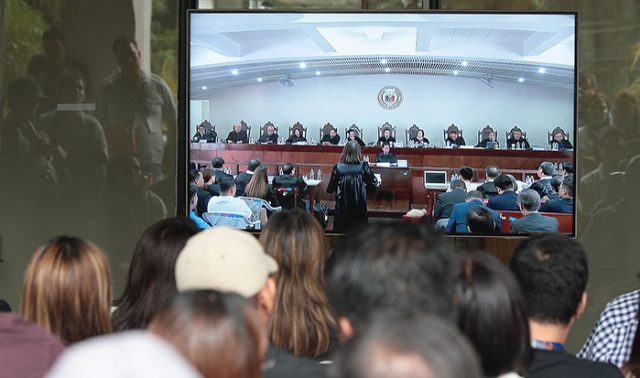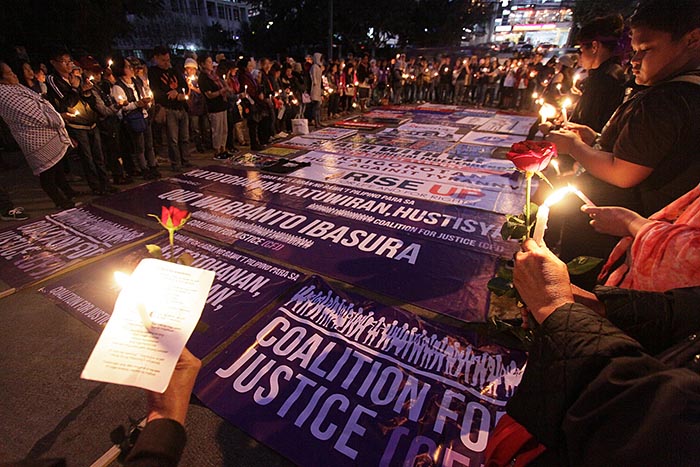
The quo warranto proceedings launched against Chief Justice Maria Lourdes Sereno saw the best legal minds of the country throw around some of the most scathing words heard in the hallowed halls of the highest tribunal in the land.
<3 this exchange:
J. De Castro: *interprets Implementing Code of Conduct and Ethical Standards for Public Officials
C.J. Sereno: That is strongly disputed. That will be shown in our memorandum to be absurd, illogical, oppressive.— The Corpus Juris ⚖ (@thecorpusjuris) April 10, 2018
The punditry, in and out of the legal field, of course had their say as noise from the Supreme Court’s summer court house in Baguio spread.
One concern brought up was the apparent lack of “cold neutrality” in the court house, supposedly evidenced by the emotional exchange between the accused Sereno and Associate Justice Teresita Leonardo-de Castro.
Are you watching today’s SC Oral Arguments? If yes, be the judge. Did the justices today observe the ‘cold neutrality’ required by law? #BayanKayoAngMaghatol@YourLawyerSays @LawStdntsofMNL @diaryniATTY @thecorpusjuris pic.twitter.com/T86hpi38F3
— Jose Angelo Tiglao (@angelotiglao) April 10, 2018
Regardless of your opinion about the substantive questions raised, it is clear that the Supreme Court is diminished by these quo warranto proceedings.
How very unfortunate for an institution that relies so heavily on civility and the image of a cold and neutral impartial judge.
— florin hilbay (@fthilbay) April 10, 2018
What is ‘cold neutrality’?
The concept of cold neutrality in court hearings can be traced to the 1997 case of Webb v. The People of the Philippines. Here the court describes “cold neutrality” as something that is impossible detach from the Bill of Rights enshrined by the 1987 Constitution.
“We have ingrained the jurisprudence that every litigant is entitled to nothing less than the cold neutrality of an impartial judge for all the other elements of due process.”
“We have ingrained the jurisprudence that every litigant is entitled to nothing less than the cold neutrality of an impartial judge for all the other elements of due process, like notice and hearing, would be meaningless if the ultimate decision would come from a partial and biased judge,” writes former chief justice Reynato Puno in his ponencia.

Citing Section 1 Rule 137 of the Revised Rules of Court, Puno goes on to discuss the importance of having an impartial judge presiding over a case.
“Under the second paragraph, a party has the right to seek the inhibition or disqualification of a judge who does not appear to be wholly free, disinterested, impartial and independent in handling the case.
“This right must be weighed with the duty of a judge to decide cases without fear of repression. Hence, to disqualify a judge on the ground of bias and prejudice the movant must prove the same by clear and convincing evidence.”
As the high court held, a petitioner has the right to ensure that the juror handling the case is one without any malice or bias that can cloud one’s judgement. Hence, cold neutrality.
Some impute lack of evidence, faulty legal reasoning and politically-motivated bias on the part of the embattled chief magistrate’s prosecution in questioning whether her accusers did in fact proceed with the “cold neutrality of judges” expected of any juror.
Lourdes Sereno, the chief justice with all the wounds inflicted on her emerges as the strongest of them all! not even Du30 lies and De Castro’s anger can destroy her.#StandWithCJSereno
— Lola Justice Terry (@ApoTerry) April 10, 2018
If there are divergent views on the quo warranto case, it must be decided on the basis of check-and-balance, the heart of a democracy.The SC cannot check itself by ousting its own CJ — otherwise majority of them can change CJs every year by connivance.
— Mel Sta.Maria (@attymeltweet) April 10, 2018
The distrust of Sereno’s camp toward the prosecution is in contrast with the confidence her predecessor, the late former chief justice Renato Corona, had in the days leading up to the impeachment trial that would strip him of his post
Schism in the courtroom
Another point of debate on the issue of impartiality is the dismissal of Sereno’s motions calling for five justices she accused of bias and prejudice to inhibit from the case.
To reiterate, past decisions have never historically been made a basis for inhibition unless a judge sat in the same case. That kind of doctrine would lead to absurd and unjust results. Further, inhibition and the strength of defense are not incompatible concepts. 1/2 https://t.co/XubHhgi9jI
— The Corpus Juris (@thecorpusjuris) April 11, 2018
In her motion, Sereno cited the New Code of Judicial Conduct.Under Canon 3, Sec.5(a) of the rule, judges are required to disqualify themselves from a proceeding should they have personal bias or prejudice against any party in the proceeding.
Reports early in the impeachment proceeding detailed an apparent schism in the court.
Related:
Separation of powers and what it means (or doesn’t) to Duterte









